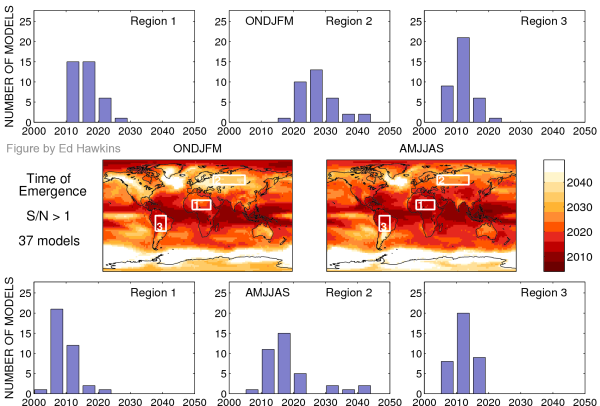The ‘signal’ of a warming climate is emerging against a background ‘noise’ of natural internal variability. Both the magnitude of the signal and the noise vary spatially and seasonally. As society and ecosystems tend to be somewhat adapted to natural variability, some of the impacts of any change will be felt when the signal becomes large relative to the noise. So, it is important to note where and when this might occur.
The concept of a ‘time of emergence’ (ToE) has been discussed by several authors and the IPCC AR5 includes a section (11.3.2.1.2) on when and where the temperature signal will emerge. Each model’s ToE is defined using the standard deviation from a control simulation as the noise (N), and the temperature change since the mean of 1986-2005 as the signal (S).
The figure below (Fig. 11.11) shows maps of the median year in which S/N becomes larger than 1. The darker red colours, indicating earlier ToE, are found in the tropics. Even though the signal of change is not largest in the tropics, the variability tends to be smaller than at higher latitudes, thus giving earlier emergence times. The histograms illustrate the uncertainty in ToE for particular area averages, which is due to uncertainty in both the signal and the noise in different models.
In summary, near-term increases in temperature, relative to background variability, are expected to occur more rapidly in the tropics and sub-tropics than in mid-latitudes. Note however that this ToE metric is likely to be very different for other climate variables such as precipitation, winds or extremes.
Some relevant literature: Mahlstein et al. 2011 (country level emergence), Hawkins & Sutton, 2012 (projections of ToE), Ho et al. 2013 (demonstrates SST changes have already emerged in tropics)

A really useful analysis. One question: This defines ’emergence’ as signal > SD of noise. Doesn’t it actually need to be >2*SD to be significant?
@cwhope
Thanks Chris – this choice of S/N ratio is not necessarily about detecting a change, but where a change might start having larger impacts. The underlying paper (Hawkins & Sutton 2012) shows maps for S/N of 1 and 2.
Cheers,
Ed.
Ed,
Are you aware of this notice by Mora, on his website:
http://www.soc.hawaii.edu/mora/PublicationsCopyRighted/Clarifications.html
wherein he credits you for informing him of other studies in the same vein, which he then lists, and apologizes for omitting from their new Nature paper.
I’m curious as to how he can say “After our paper was published in Nature…”. Their paper was published on either Oct 9 or 10, and your blog post here is dated Oct 1. Is he referring to something other than this blog piece there?
Regardless of the specifics, I find it pretty illuminating that someone could get a paper published in Nature on this topic, and yet not even cite a number of very recent studies of the same type. This would be a pretty clear indication that Mora et al are not up on the literature on the topic.
Hi Jim,
I emailed Camilo Mora after the paper was published to point out the missing papers and mentioned this blog post also. The key conclusion – that tropical areas emerge first – is also in the IPCC AR5 SPM because of all the previous work.
It appears from correspondence with Mora that neither they or the reviewers were aware of the previous papers, which is rather surprising. I give Camilo Mora credit for openly apologising to those whose work he had not seen.
cheers,
Ed.
Thank you Ed. I agree that they deserve credit for apologizing publicly for the oversight. It does bother me that they were not aware of them to begin with.